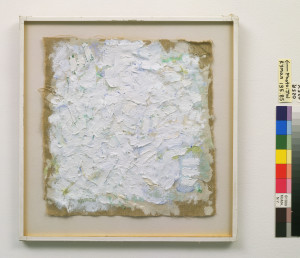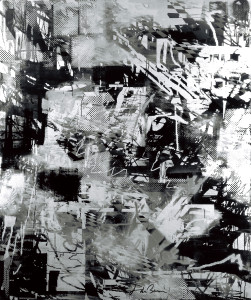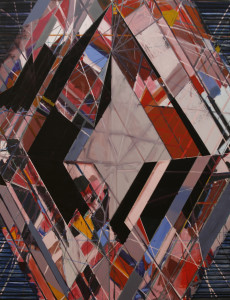Painters Frame Contemporary Painting
Painting has died and been resurrected several times in recent decades. Challenged by theory-laden conversations about art’s “post-medium” condition and a welter of deconstructionist propositions, painting seems nevertheless to have thrived in the face of adversity. Some would say it remains as manifold and imaginative as ever. In order to take its pulse, Image asked four painters to reflect on the work of any of their contemporaries who interest them. The four artists—Wayne Adams, Alfonse Borysewicz, Catherine Prescott, and Tim Rollins—are a diverse bunch. They paint in a variety of styles and differ in their level of engagement with art theory. Yet without prompting, all four suggested that they regard authenticity of statement as the most valuable—if not also the most elusive—quality in contemporary painting: They share a concern for the integrity of the painting as the arena where material meets meaning. Our thanks to James Romaine for organizing this symposium. The following is Wayne Adams’s contribution.
PAINTING is a problem. Or maybe it’s better to call it a series of problems. When you become a painter, you take on two simultaneous tasks: establishing problems, and addressing them within the work.
When I naïvely set out to paint for a living, I thought that all the other occupations seemed easy. Whether it was plumbing or surgery, all you had to do was figure out the answers to the set of problems belonging to your discipline. Then you just plugged in the formula and your problems were fixed. This certainly has been the case in the information tech jobs I’ve had: with the right code or tools, you can diagnose and solve almost anything. Painting, I thought, was a better challenge, because with painting you had to invent not only the solution, but the problem as well. Looking back, I could smack my earlier self for his arrogance and presumption. But let’s focus on the subject at hand.
Lately, a lot of painters seem to be addressing a similar set of problems. A new wave of artists are once again taking on the problems of society by addressing beauty, decay and destruction. I sense that the image is generally under attack, or at least being forced into major changes. Digital photography has made it easier to take more and better pictures, and roomier hard drives allow us to store the thousands of vacation photos we can’t bring ourselves to delete. This proliferation of images has taken its toll on the dear old picture.
While most of us would be devastated if we lost our laptops or our hard drives failed before we could back up our photos, the sheer volume results in something of a devaluing of the individual snapshot. If you have fifteen thousand pictures in your iPhoto library, the value of each is less than if you had only fifty or a hundred. In galleries and museums in recent months, the result of this photographic devaluing is a declining number of pictorial representations and an increase in abstract compositions of varying degree.
I recently had the privilege of seeing the inaugural show at the new building for the New Museum in New York, titled Unmonumental. The name is appropriate. My first impression was of the low-quality materials used by nearly every artist. Despite the dumpster-dive quality of the media, much if not most of the work addressed decidedly formal issues of beauty and composition. Much of the work was beautiful even while obviously and self-consciously consisting of trash.

Plate 13. Mark Bradford. Helter Skelter I, 2007. Mixed-media collage on canvas. 12 x 34 ¼ feet. Courtesy of Sikkema Jenkins & Co.
The show featured collage, but the parallel to painting is easily made; indeed many of the so-called collages could fit within a broad definition of painting. Mark Bradford’s enormous Helter Skelter I (2007) covered most of an entire wall [see Plate 13]. It involves multiple layers of paper, posters, and magazine advertisements, but also contains areas of painted abstraction and imagery—calling to mind Robert Rauschenberg or Jean-Michel Basquiat. Nancy Spero’s The Hours of the Night II (2001) appears to include a mixture of techniques that could easily be considered painting, from the layers of thin, washy rectangles of color to mottled backgrounds that look loosely brushed. Throughout the show, imagery was appropriated from magazines, newspapers, and posters. It’s hard to walk through an exhibit of collages and not be aware of the effect on the pictorial image. When imagery was needed, it was usually borrowed from another context instead of being hand-drawn or painted. Images and photographs became another medium, like paint, to be manipulated and applied at will. Pictures were valued here for their parts, which were pulled out and combined with others to form new images. The artists seemed not to need to create new images, content to draw from the pool of pre-existing ones.
The lack of pictorial representation in paint was amplified by the physical and self-conscious nature of the work. When I say that a piece like Helter Skelter I is self-conscious, I mean that you’re immediately aware of its nontraditional and banal—even trashy—materials. Inherent to the piece is the fact that it’s made up of layers. It’s reminiscent of buildings and walls wheat-pasted with posters in cities like New York and Los Angeles. Though the materials are garbage, the effect is strangely beautiful.
The observation must be made that reconstituting detritus into paintings is not new. Indeed, it owes a huge debt to the pioneers who gave it legitimacy in the contemporary art world—most notably Robert Rauschenberg. Rauschenberg’s series of “combines,” a term coined by fellow artist Jasper Johns, popularized the use of nontraditional materials to create artworks that are neither purely paintings nor sculpture, but something in between. Works like the Rebus (1955) incorporate material from Rauschenberg’s own studio (paper, comics, political posters, drawings), as demonstrations of his idea that “a painting is more like the real world if it’s made out of the real world” Bradford and the Unmonumental artists are building on Rauschenberg’s tradition—a tribute made ironically poignant by Rauschenberg’s death during the run of the show.
The presence of painting as material in the exhibition was easy to find. You could see it on cardboard, discarded wood, Styrofoam, and magazines. It’s art gone shabby-chic. And it’s beautiful and interesting and decidedly not precious. This self-deprecation through materials reiterates the show’s title and also seems to point to an attitude of the artists themselves and, by extension, society at large (if I may be permitted a romantic extrapolation). According to the curators, “‘Unmonumental’ also describes the present as an age of crumbling symbols and broken icons.” The consideration of beauty and its reflection in a chaotic society provided these artists with quite a set of problems. In resolving these problems, decay and destruction are prominently displayed, but not without beauty’s hopeful and, I would argue, enduring presence.
On a recent trip to the various geographically separated art “neighborhoods” of LA, I couldn’t help but notice a similarity, especially in the younger galleries, to what I’d seen at the New Museum in New York. Time and time again, I encountered work whose ethos could easily have been summed up as “unmonumental.” This trend (if it can be called a trend) doesn’t necessarily mean the work is good. The inclination toward apparent sloppiness of technique and cheap materials may contribute to an influx of truly awful art, as artists try to cash in on what’s popular.

Plate 24. Robert Ryman. Untitled, 1961. Oil on unstretched linen. 10 ¾ x 10 ¼ inches. Mrs. Frank Y. Larkin and Mr. and Mrs. Gerrit Lansing Funds. Photo © Robert Ryman and the Museum of Modern Art, licensed by SCALA/Art Resource, courtesy of PaceWildenstein, New York. Image licenced to Mary Kenagy IMAGE by Mary Kenagy Usage : – 2000 X 2000 pixels © Digital Image © The Museum of Modern Art/Licensed by SCALA / Art Resource
A handful of new artists, however, are working through the problems of an unmonumental ethos with notable aplomb. Though many established artists, from Rauschenberg and Johns to Sarah Sze and Jessica Stockholder, can claim to have influenced the trend for banal materials, assemblage, and the junk aesthetic, I want to highlight three young and emerging painters: John Bauer, Jered Sprecher, and Mike Cloud. Each approaches the problems of material, self-consciousness, and beauty in a unique way.
Bauer, who is originally from southern California, is a New York artist recently relocated to LA, whose striking, monochromatic paintings have recently received acclaim. His bombastic black and white abstractions call to mind punk rock or Japanese noise music. Where other painters like Robert Ryman [see Plate 24] and Christopher Wool explore the nature and significance of painting as a medium, Ryman through paint’s physical relation to its support and Wool through its flatness, Bauer draws the two explorations together by making works that simultaneously call attention to their material and depth. Chernobyl (2006) is a silver and black cacophony of spray marks, direct marks, serially repeated marks, splatters, bitmapped lines, and a digital grid [see Plate 14]. His material may be that of a more conventional painter, but his imagery boasts layers of scrawls, drips, and throw-away marks. Standing in front of it, you cannot escape the sense of a chaotic and destructive space created by the painting techniques and their combinations. The spaces Bauer creates may hint at empirical black-and-white realities, but they are resolved in the chaotic working out of beautiful and complex silvers and grays.

Plate 14. John Bauer. Chernobyl, 2006. Oil and mixed-media on linen. 93 x 78 inches. Collection: Saatchi Gallery, London.
Jered Sprecher is based in Knoxville, where he teaches at the University of Tennessee. He recently participated in the Space Program of the Marie Walsh Sharpe Foundation and held a residency at the Irish Museum of Modern Art. Through his paintings, Sprecher captures and explores particular moments in his cultural environment. His works may draw from the myriad images he gathers—or the precise structures of crystals—but in all cases they demonstrate an acute awareness of their own materials while referencing (though not depicting) specific imagery. Of the three artists, he comes nearest to using actual imagery, yet for the most part his paintings would rather evoke than declare. To look at his work is to get a sense of things, rather than having things explained to you. His acute selection of references to beauty and perfection in diamonds and digital technology is balanced by the looseness of his brushstrokes and the beautifully awkward mixing of his color palette. Redux (2006) is a monumental vortex that recalls both 2001: A Space Odyssey and fake plastic jewelry [see Plate 15].

Plate 15. Jered Sprecher. Redux, 2006. Oil on canvas. 96 x 72 inches. Courtesy of the artist and Jeff Bailey Gallery.
Mike Cloud takes a self-conscious awareness of materials to another level, leaving the structures and edges of his paintings exposed. Originally from Chicago, Cloud received his training at the University of Illinois, Chicago, and Yale, where he did his MFA. Now based in New York, he is represented by the Max Protech Gallery. Where Bauer and Sprecher use implied imagery and paint itself as a vehicle for dialogue, Cloud expands the conversation to the very frame and canvas. He sometimes goes so far as to build objects (namely toys) onto their surfaces. His Chicken with Two Stars of David (2005), an heir to Rauschenberg’s combines, is a bold leap from a conception of painting as a surface paralleling the wall to painting as a free-standing object.
These three artists walk a fine line between the gimmicky and the sublime, but feats this daring deserve all the more glory. I wouldn’t call their work universally beautiful, but it all has an inherent appeal. The three seem to acknowledge the effects of entropy while resolving their compositions with simple beauty.
So what? Is there any significance to the trash aesthetic? I would argue that this unmonumental work reflects attitudes that underlie American culture at large. Today the sense that there is beauty nearly everywhere in the world, even among our refuse, seems painfully balanced by the sense that we humans have nearly succeeded in destroying it all. You don’t have to watch An Inconvenient Truth to notice the world’s tragic condition. Just reading the news can suffice. The Unmonumental artists are tackling some of the most urgent problems facing our world. As the curators write, these artists “exploit the power of found images to communicate the unease, displacement, and anger peculiar to our times.”
While I don’t believe that the world’s moral, environmental, and economic solutions are to be found on canvases, I don’t think it’s grandiose to give artists a place in this conversation. There is an urgent need for artists to reiterate the power of transcendent beauty in everyday things—value in the valueless, hope in the hopeless. These expressions, whatever their form, are important for us to observe, contemplate, and perhaps act upon, for in them we have articulations, however abstract, of what the problems are and where (potentially) the answers lie.
And what does all this have to do with my digital photographs? Perhaps my feeling that the value of images is under attack through over-use is just a local reflection of a larger problem; perhaps my image of the world is under attack from over-use as well. I have been wondering if my degree of value for images (of my world) is somehow linked to how I value my world itself. If the image of a thing becomes devalued to the point that we do not care about it at all, how does that reflect on our attitude toward the thing itself? I guess I need to get painting and figure it out.
Wayne Adams is a Brooklyn-based artist who has exhibited throughout the Midwest and in New York and Vienna, including recently at Alogon Gallery in Chicago, the New York Center for Art and Media Studies, and Pole Position Gallery in Brooklyn.





